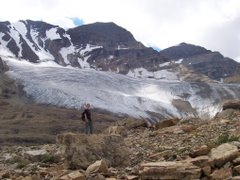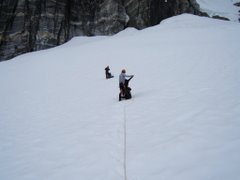UPDATE- Ed Boyle's talk was very exciting- hydrothermal sources of iron to the ocean!!! And he graciously agreed to send me his metal sampling methods, which employ a quicker and cleaner filtration method that will save future lab hours.
Lonnie Thompson just popped in with Ed Boyle! This broke me from a writing induced trance. It is only appropriate that Dr. Boyle materialized... if ever anyone wondered what happened to metals in the environment, Ed Boyle is the person to ask. (I can't wait for his talk this afternoon!)
Why are metals a problem? Metals, especially in dissolved form, may be ingested by organisms in some cases replacing vital nutrients. Metal poisoning has been shown to compromise the health of smallest organisms to the largest mammals (including humans). Documented poisonings occurred as far back as Roman times- where it has been argued that metal smelting contributed to the death of those living near smelters.
Industrial activities (primarily burning fossil fuel and metal smelting) have increased the emission of many metals into the atmosphere, but perhaps worse, is that many of these metals are released in mine tailings and sewage sludge into soils... and waterways. Their release is usually not a one time event. Many metals bind to sediment and are rereleased into the environment with flood events.
Ed Boyle's research group primarily studies the fate of metals in the ocean. This includes investigating the nutrient capabilities of iron, acting as a fertilizer that increases oceanic productivity. Examining cadmium to understand deep ocean-shallow ocean interactions through time (cadmium distribution in the ocean is not homogeneous and is thought to relate to the connectivity between deep to shallow circulation). Changes in ocean circulation are likely tied to major changes in climate. I could go on and on... but I need to finish this paper today...and think of a few questions for Ed...
Thursday, February 14, 2008
Tuesday, February 12, 2008
As the cake flows
This week while I alternated between dissertationing and running many miles my husband, Trey, crafted a glacier for my birthday. I, and several geology-loving friends, appreciated Trey's masterful attention to detail as he included lateral and terminal moraines (rocks scraped and piled along the glacier margin and snout) as well as a cryoconite hole and a proglacial lake. Fortunately, there was no life living in that cryoconite hole... and we all had our fill of buttery cream. In a few weeks for Women In Science Day I am hosting a 2 hour clinic for 60ish 7-10th grade girls on glacier dynamics. Normally, I'd use flubber (a glue-borax hybrid), but after seeing this cake, there may be some advantages to butter cream.


Subscribe to:
Comments (Atom)


